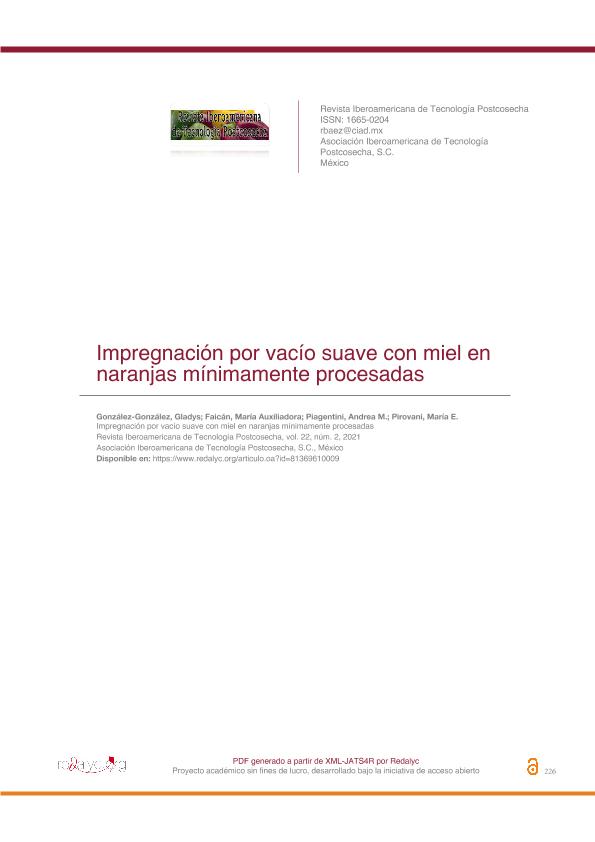Artículo
El objetivo de la investigación fue evaluar el efecto del tratamiento de impregnación al vacío (IV) con miel en naranjas mínimamente procesadas. La metodología de superficie de respuesta fue usada para evaluar el efecto de la presión de vacío (P:2-18 inHg) y el tiempo de tratamiento (t:14-42 min) en la ganancia de sólidos (SG), pérdida de agua (WL), reducción de peso (WR), color (L*i , C*abi y habi), firmeza (Fi), sólidos solubles (SSi) y pH (pHi) de octavos de naranja impregnados a vacío (OIV) con miel el día (i) del tratamiento (0 d) y luego del almacenamiento a 2 ºC (8 d). Las respuestas afectadas por las variables del proceso fueron SG, WL, WR, L*0, F0, y SS0, de las que se obtuvieron modelos predictivos. En general, hubo una ganancia de sólidos procedentes de la miel, pérdida de agua y un incremento de sólidos solubles en OIV, después de la IV. Además, ocurrió una reducción de la luminosidad y peso. Para las demás respuestas, que no fueron función de las variables del proceso, no se obtuvieron modelos predictivos. Por lo tanto, se estimó el valor promedio, dentro del rango experimental. En el día 0, la cromaticidad de OIV era ligeramente superior (5%) a la de los octavos sin impregnar (OSI), mientras que el tono y pH fue similar. En el día 8, tanto la cromaticidad como el tono se incrementaron (15 y 4%, respectivamente) y la luminosidad resulto similar a OSI. La firmeza y sólidos solubles de OIV fue mayor (17 y 41%, respectivamente) que OSI, sin cambios evidentes en pH. Los resultados indicaron que el uso de miel aplicada por IV tiene un gran potencial para el desarrollo de un producto diferenciado (naranjas mínimamente procesadas con miel). The aim of the research was to evaluate the effect of the vacuum impregnation (VI) treatment with honey in minimally processed oranges. Response surface methodology was used to evaluate the effect of vacuum pressure (P:2-18 inHg) and treatment time (t:14-42 min) on solid gain (SG), water loss (WL), weight reduction (WR), colour (L*i , C*abi y habi), firmness (Fi), soluble solids (SSi) and pH (CpHi) for eighths of orange vacuum impregnated (OIV) with honey on day (i) of treatment (0) and aer storage at 2 °C (8). The responses affected by the process variables were SG, WL, WR, L*0, F0, SS0, from which predictive models were obtained. In general, there was a gain in solids from honey, loss of water and an increase in soluble solids in OIV, after IV. In addition, a reduction in luminosity and weight occurred. For the other responses, which were not a function of the process variables, no predictive models were obtained. Therefore, the average value was estimated, within the experimental range. At day 0, the chromaticity of OIV was slightly higher (5%) than that of the eighths without impregnation (OSI), while the tone and pH were similar. On day 8, both the chromaticity and hue were increased (15 and 4%, respectively) and the luminosity was similar to OSI. The firmness and soluble solids of OIV was greater (17 and 41%, respectively) than OSI, with no obvious change in pH. The results indicated that the use of honey applied by IV has great potential for the development of a differentiated product (oranges minimally processed with honey).
Impregnación por vacío suave con miel en naranjas mínimamente procesadas
Título:
Mild vacuum impregnation with honey of minimally processed oranges
González González, Gladys ; Faicán Benenaula, María Auxiliadora
; Faicán Benenaula, María Auxiliadora ; Piagentini, Andrea; Pirovani, Maria Elida
; Piagentini, Andrea; Pirovani, Maria Elida
 ; Faicán Benenaula, María Auxiliadora
; Faicán Benenaula, María Auxiliadora ; Piagentini, Andrea; Pirovani, Maria Elida
; Piagentini, Andrea; Pirovani, Maria Elida
Fecha de publicación:
12/2021
Editorial:
Asociación Iberoamericana de Tecnología Postcosecha
Revista:
Revista Iberoamericana de Tecnología Postcosecha
ISSN:
1665-0204
Idioma:
Español
Tipo de recurso:
Artículo publicado
Clasificación temática:
Resumen
Archivos asociados
Licencia
Identificadores
Colecciones
Articulos(CCT - SANTA FE)
Articulos de CTRO.CIENTIFICO TECNOL.CONICET - SANTA FE
Articulos de CTRO.CIENTIFICO TECNOL.CONICET - SANTA FE
Citación
González González, Gladys; Faicán Benenaula, María Auxiliadora; Piagentini, Andrea; Pirovani, Maria Elida; Impregnación por vacío suave con miel en naranjas mínimamente procesadas; Asociación Iberoamericana de Tecnología Postcosecha; Revista Iberoamericana de Tecnología Postcosecha; 22; 2; 12-2021; 226-240
Compartir



